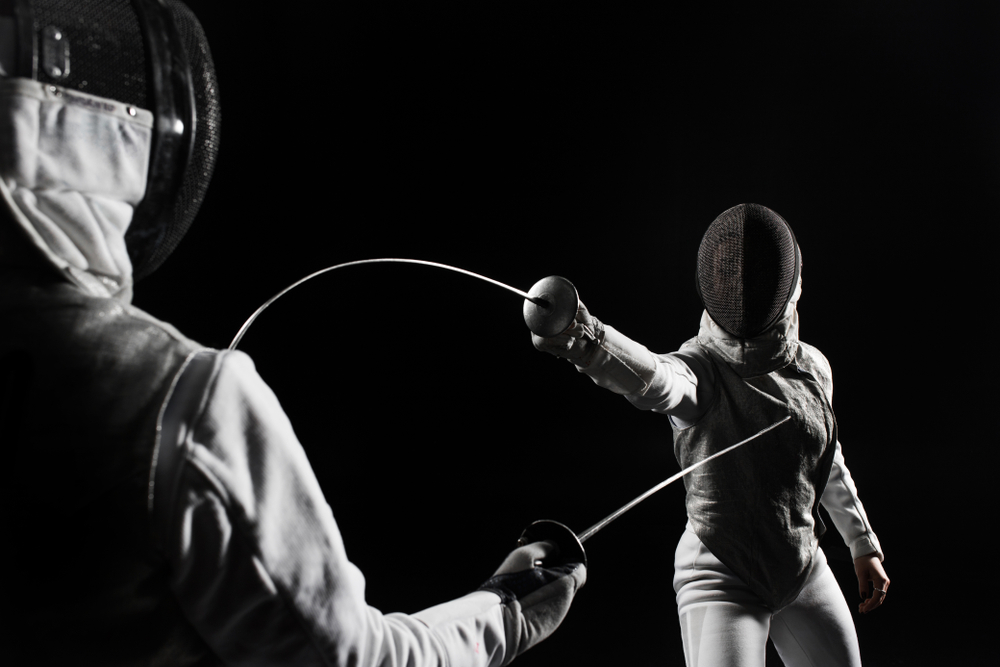Female Fencer Handed Severe Punishment After Refusing To Partake With Transgender Opponent

What happens when personal beliefs clash with institutional rules—not in a courtroom, but on a high school gym floor? That’s the question now echoing through a Maryland school district after a young female fencer refused to compete against a transgender opponent and was handed an indefinite suspension from her team. The moment lasted only minutes, but the fallout has triggered a ripple effect far beyond the fencing piste, reaching into debates about fairness, identity, and the boundaries of student rights.
It’s easy to speak in absolutes when you’re watching from the sidelines. But what if this were your child—your sibling—your team? In a time when young people are already navigating complex identities, peer dynamics, and academic pressure, this case isn’t just about policy. It’s about the weight we ask teenagers to carry, and how we respond when their choices don’t fit cleanly into the systems we’ve created.

The Moment That Sparked Controversy
At a Maryland high school fencing competition, what was expected to be a routine match quickly became a national flashpoint. A female student-athlete made a personal decision that would ignite debates far beyond the school gym—she refused to compete against a transgender opponent. Her refusal wasn’t accompanied by loud protest or disruption. It was a quiet act, one reportedly rooted in personal belief, made in a moment of decision during a sporting event. Yet that moment sent shockwaves through the community and beyond, triggering intense conversations about inclusion, fairness, and freedom of conscience.
The school’s response was immediate and unequivocal. The student was suspended indefinitely from the fencing team, a disciplinary action that quickly drew attention both locally and nationally. For the administration, the decision was presented as one of policy enforcement—upholding rules meant to create a safe and inclusive environment for all students, including transgender athletes. But for critics of the decision, it raised uncomfortable questions. Was the student punished for discrimination, or for simply acting in line with her beliefs? Was the suspension proportionate to her action? And who, in that moment, was the school ultimately trying to protect?
This incident didn’t unfold in isolation. It happened in the context of a nation already deeply divided on issues surrounding gender identity, youth sports, and the extent to which individuals—especially minors—can or should be compelled to act against personal convictions. It exposed the friction that surfaces when institutional rules intersect with personal identity and belief, especially in emotionally charged environments like youth sports. The fencing match itself ended in silence, but the debate it sparked has only grown louder, revealing the challenges schools face when navigating values that are no longer universally shared.

The Penalty and the Reaction
The indefinite suspension handed down to the student wasn’t just a disciplinary note—it was a statement. In the eyes of the school, declining to participate in the match with a transgender student was a breach of team expectations and possibly a violation of anti-discrimination policies. While no formal comment from the fencer or her family has surfaced publicly, her decision and its consequences have become a powerful symbol in a wider societal conversation. Without a word from the student herself, narratives quickly formed on both sides, turning her into a stand-in for clashing cultural ideologies.
For the transgender athlete involved, little is known publicly, and that silence is telling. Often, the people most affected by public discourse are the ones who remain invisible in it. While the suspended student has been at the center of public attention, the transgender fencer—simply present and ready to compete—has largely been left out of the conversation, except as a symbol. This imbalance reflects a larger trend in how stories like these are told: more about the controversy than the individuals caught in it. Behind the headlines are two teenagers, both showing up to play a sport they care about, both now carrying the emotional burden of national debate.
The broader community reaction has been predictably divided. Some students and parents have come forward to support the school’s decision, framing it as a necessary step to defend the dignity of all athletes. Others argue that the school overreached, silencing a student for acting on conscience. The polarization is stark, but perhaps most troubling is the speed with which the young fencer’s decision was politicized. Instead of encouraging discussion or education, the response—on all sides—has leaned into outrage. And in that outrage, the nuances of youth, context, and individual humanity are often lost.

Policy vs. Personal Belief: Where They Collide
Public school systems operate within legal and policy frameworks designed to protect students from discrimination and promote equity. In Maryland, as in many other states, those policies include affirming the rights of transgender students to compete in alignment with their gender identity. These guidelines are grounded in federal protections under Title IX, which prohibits sex-based discrimination in education. For schools, following these rules is not optional. They’re part of creating a learning environment where all students feel seen, respected, and safe. But when a student’s deeply held personal or religious beliefs lead them to decline participation, the rules meet resistance in real time.
The female fencer’s decision not to compete was reportedly quiet and composed—an expression of personal conviction, not protest. And yet, it triggered immediate disciplinary action. This moment exposes one of the deepest challenges in public education today: how to fairly balance the rights of one student without infringing upon those of another. Schools are asked to protect every child’s right to feel safe and respected. But when students’ definitions of safety or respect differ based on belief systems, enforcing a single standard can sometimes feel like choosing sides. The school believed it was protecting a transgender student from exclusion; the suspended athlete’s supporters argue her freedom of belief was dismissed.
Legal scholars and civil rights experts have increasingly been weighing in on this space. While courts have upheld the +69s, they’ve also recognized the need for schools to consider freedom of expression and religious rights. But these issues become even more complicated when applied to children and teenagers. There are no easy legal templates when moral values, identity, and institutional expectations clash. Every case, every context, requires thoughtfulness that extends beyond the letter of the law. And in the absence of clear consensus, schools are left to interpret and enforce in ways that inevitably invite scrutiny and disagreement.

The Bigger Conversation: Fairness, Inclusion, and Boundaries
This single fencing match has brought forward one of the most complex questions facing modern education and youth sports: what does fairness truly mean? For many transgender advocates, the answer is clear. Fairness means access—being allowed to compete, participate, and be recognized according to one’s gender identity. Denying that, they argue, perpetuates exclusion and harm. It sends a message that some identities are still not welcome. For these advocates, rules that allow transgender athletes to participate openly are not only inclusive—they are a matter of dignity and survival for students who are often marginalized.
At the same time, others—ranging from parents to athletes to legislators—have raised concerns about competitive equity. Especially in sports where physicality matters, they argue, biological differences can impact outcomes. These concerns have led to legislative proposals across the U.S. to restrict or redefine participation policies. While some of these efforts stem from genuine concern over fairness, others are driven by political agendas, which makes it hard to separate science from rhetoric. But the concerns remain: how do we make room for inclusion without dismissing questions of equity?
This is the heart of the debate, and it’s one that resists binary answers. There is no one-size-fits-all solution that will make everyone feel heard, safe, or validated. That’s what makes this so hard—and so necessary to keep talking about. Rather than frame the issue as fairness versus inclusion, perhaps we need to redefine what both actually mean in our communities. Maybe fairness is not always equal treatment but thoughtful response. Maybe inclusion isn’t just about access, but about understanding. These are the conversations we must have, not through sound bites, but through ongoing reflection and open-hearted listening.
The Student Experience: Adolescents Caught in the Crossfire
Adolescents today face a kind of pressure most adults didn’t have to navigate at their age. With every choice—every opinion, every action—subject to public scrutiny through social media, the stakes feel impossibly high. The young female fencer in Maryland likely didn’t expect to become the focal point of a national debate. She made a decision in a specific moment, possibly influenced by her upbringing, beliefs, or values. That decision may or may not align with broader public opinion—but she made it honestly. And now, she’s living with the consequences in a way that would be difficult for any teenager.
The same is true for the transgender athlete who was ready to compete. Their readiness to step onto the piste was not a political act, but an expression of identity and self-acceptance. Being declined by an opponent—regardless of the reasoning—likely felt personal, even if it wasn’t meant to be. That experience, too, carries weight. When adults debate these issues, it’s easy to forget the emotional toll they take on the students at the center. These young people are still forming their sense of self. Every interaction—especially one magnified by the media—can shape how they see themselves and how they feel seen by others.
Schools must do more than enforce rules. They must hold space for complexity, especially when it comes to students who are still figuring things out. Creating an inclusive environment should not come at the cost of silencing difference. At the same time, honoring individual belief should not mean denying others their right to belong. This is the difficult middle ground educators must occupy. It is not easy. But it is essential. Because our students are watching how we respond, how we listen, and how we lead. And they are learning what it means to be human from every one of our choices.
What This Means Going Forward
This incident in Maryland is part of a much larger national conversation that is only gaining momentum. Across the United States, questions about transgender participation in sports are being raised in legislatures, courts, and school boards. For every policy created, there are exceptions, edge cases, and human stories that challenge its clarity. This case may prompt legal review or public backlash, or it may quietly set precedent for how future situations are handled. Regardless, it has highlighted a fundamental tension in education today: the need to protect while also allowing space for conscience.
Advocacy groups on both sides are already using this incident to bolster their messaging. Civil rights organizations may point to the school’s decision as a sign of progress in creating safe spaces for trans youth. Religious and conservative groups may argue it’s an example of belief being punished. And while these broader narratives unfold, the reality for schools is even messier. They must make decisions without perfect information, with limited time, and under immense scrutiny. In doing so, they often find themselves in the impossible position of disappointing someone, no matter what choice they make.
What this case underscores is the need for deeper frameworks—ones that go beyond compliance and into the realm of moral and emotional intelligence. Policy alone cannot hold the weight of these cultural questions. Institutions must create pathways for discussion, education, and restorative justice. They must ask not only what the rule says but what the situation needs. And most of all, they must center the students—not as tools for ideological battles, but as whole people with needs, beliefs, and futures still being shaped.
How Do We Talk About This?
We don’t need more noise. We need more nuance. The conversation surrounding this fencing match should not be about who won or lost—but about what we’re learning. These situations are uncomfortable, not because someone failed, but because the world is changing and we’re all trying to catch up. The question is: can we talk about change without shutting each other down? Can we create space for disagreement without losing our humanity in the process?
No teenager should be turned into a headline. No student’s identity should be reduced to a debate. Yet here we are, again, watching a deeply personal moment become national commentary. And it’s worth asking: what are we teaching our kids when we model outrage before empathy, and reaction before reflection? If we want a generation that can lead with compassion, we have to show them what that looks like—even when it’s inconvenient. Especially when it’s inconvenient.
So perhaps the most important lesson from this story isn’t legal or political—it’s relational. How do we treat one another when we disagree? How do we hold both truth and kindness in the same breath? These are the questions that define not just schools, but society. And how we answer them will shape far more than fencing matches. It will shape who we become.
Loading...






